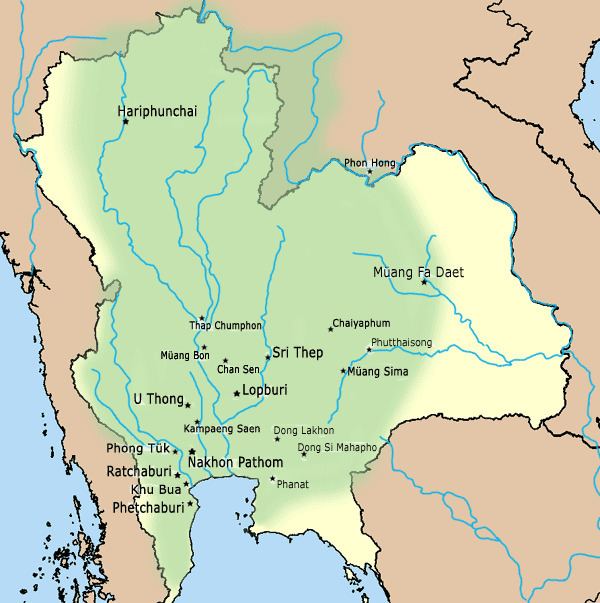 | ||
The Dvaravati (Thai: ทวารวดี, rtgs: Thawarawadi) period lasted from the 6th to the 13th centuries. Dvaravati refers to both a culture and a disparate conglomerate of principalities.
Contents
History
The Mon Kingdom of Dvaravati, which may have existed as early as the fifth century, was controlling the Buddhist sites of Phra Pathom and Phong Tuk by at least the seventh century; legends engraved on royal urns report the following kings: Suryavikrama (673-688), Harivikrama (688-695), Sihavikrama (695-718). A Khmer inscription dated 937 documents a line of princes of Chanasapura started by a Bhagadatta and ended by a Sundaravarman and his sons Narapatisimhavarman and Mangalavarman. But at that time, the 10th century, Dvaravati began to come under the influence of the Khmer Empire and central Thailand was ultimately invaded by King Suryavarman II in the first half of the 12th century. Hariphunchai survived its southern progenitors until the late 13th century AD when it was incorporated in the Lanna Kingdom. The people of the region used the Mon language, but whether they were Mon people is unknown. There is evidence that these principalities may comprise many cultural groups of people, including Malays and Khmer people. The theory of Thai migration into Dvaravati has been refuted and is now known to have happened much later.
The term Dvaravati derives from coins which were inscribed in Sanskrit śrī dvāravatī. The Sanskrit word dvāravatī means "that which has gates" (from dvar "door gate"). Its name may derive from the city of Dvārakā in ancient India.
Little is known about the administration of Dvaravati. It might simply have been a loose gathering of chiefdoms rather than a centralised state, expanding from the coastal area of the upper peninsula to the riverine region of Chao Phraya River. Hinduism and Buddhism were significant. The three largest settlements appear to have been at Nakhon Pathom, Suphanburi, Praak Srigacha, with additional centers at U Thong, Chansen, Khu Bua, Pong Tuk, Muang Phra Rot, Lopburi, Si Mahasod, Kamphaeng Saen, Dong Lakhorn, U-Taphao, Ban Khu Muang, and Sri Thep.
The traditional chronology of Dvaravati is mainly based on the Chinese textual account and stylistic comparison by art historians. However,the results from excavations in Chansen and Tha Muang mound at U-Thong do not support the traditional dating. Newly dated typical Dvaravati cultural items from the site of U-Tong indicate that the starting point of the tradition of Dvaravati culture can be pushed back to 200 CE and lasted until 600 CE. Thus a tradition of "Early" or"Proto-Dvaravati culture" might have been established during this period.
Art
Dvaravati itself was heavily influenced by Indian culture, and played an important role in introducing Buddhism and particularly Buddhist art to the region. Stucco motifs on the religious monuments include garudas, makaras, and Nāgas. Additionally, groups of musicians have been portrayed with their instruments, prisoners, females with their attendants, soldiers indicative of social life. Votive tablets have also been found, also moulds for tin amulets, pottery, terracotta trays, and a bronze chandelier, earring, bells and cymbals.
